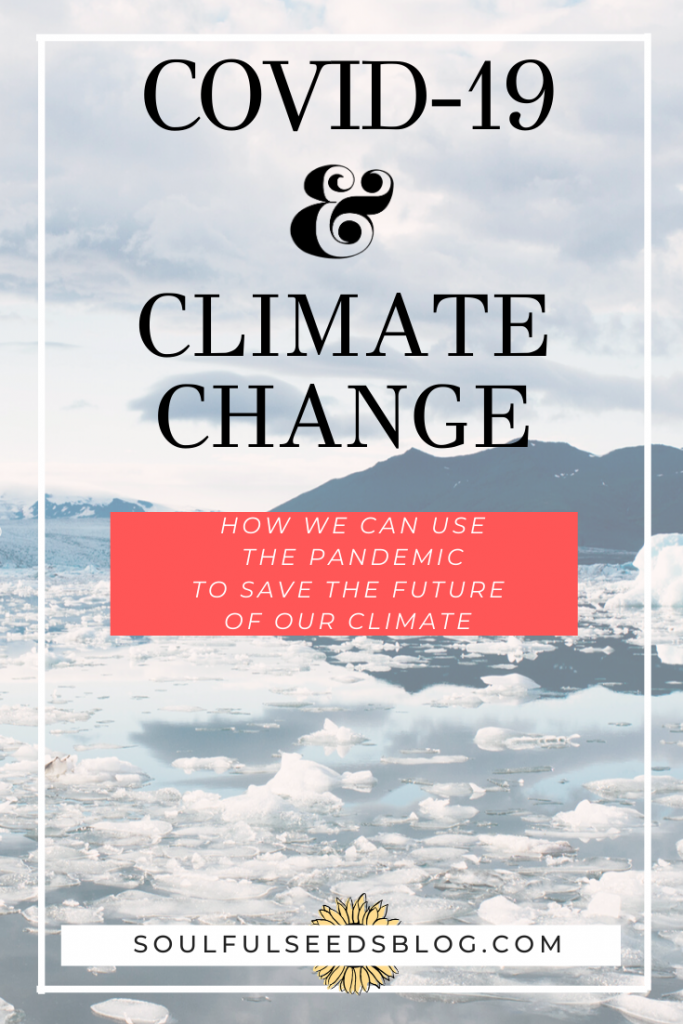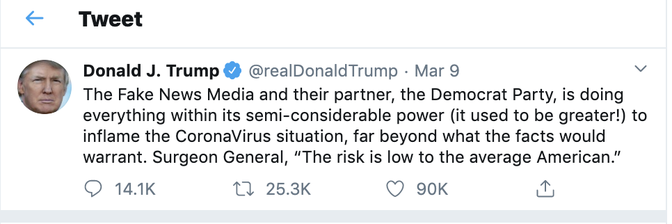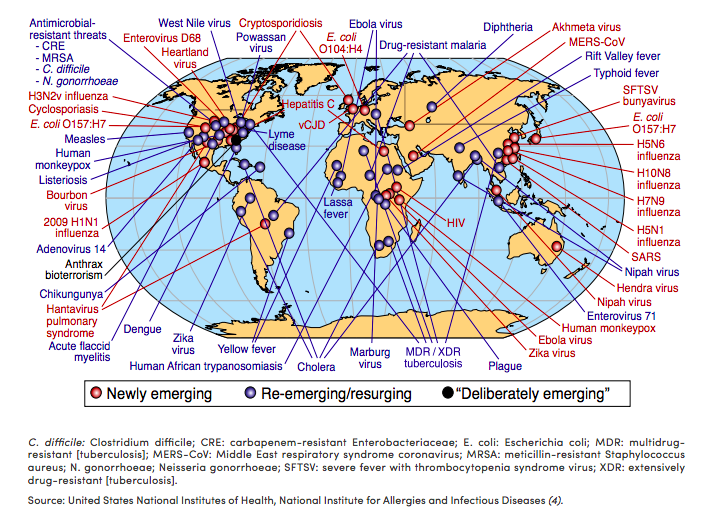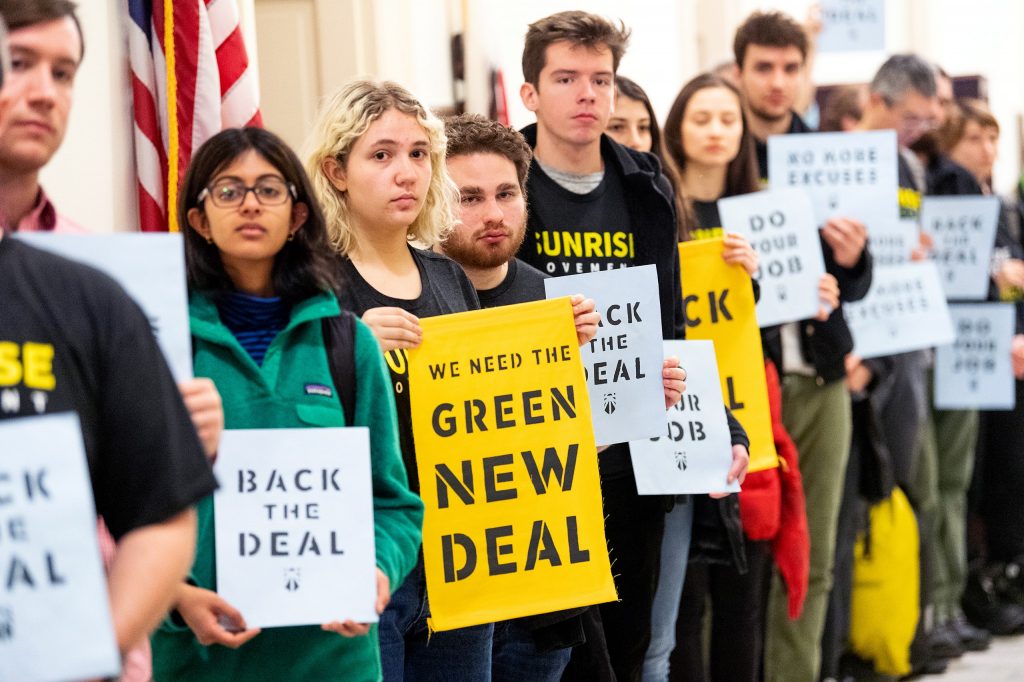If anything can come from this pandemic, it might be the wake up call to our inability to properly deal with global crises. But 235,000 people (and counting) should not have to die in order for our government and civil society to respond to crises that are knocking at our door.

Parallels between Coronavirus and Climate Change
There are striking similarities between our government’s response to COVID-19 and their response to climate change concerns. Several months and even years before the outbreak started, scientists like Dr. Li Wenliang and Peter Daszak sounded the alarm about the impending threat of a global virus. Instead of heeding these warnings and establishing a plan of action for a potential pandemic, governments across the world remained silent. Global and U.S. officials across the nation discarded these warnings as little more than distractions from global economic growth. Below is a tweet from the President of the U.S. himself which undermines the severity of the virus and is an example of the harmful mindset that many in our country had before the virus hit us hard.

Similarly, scientists have been warning politicians about the looming threats of climate change for years and years.
Dr. Chuck Kutscher, Fellow and Senior Research Associate at the University of Colorado-Boulder Renewable & Sustainable Energy Institute, wrote this article outlining five key areas pertaining to both the Coronavirus crisis and the climate crisis where the government has demonstrated its failure to heed warnings, comprehend the delay between the problem and its consequences, and neglect disinformation, along with the lack of adequate federal leadership (Kutscher, 2020).
COVID-19 has shown us how vulnerable our population is to the sways of nature. Citizens think that we can do whatever we want on this earth– treading as we please and stomping on the ground as if it is ours to conquer. But just as the human body regulates in order to maintain homeostasis, the natural earth reorganizes through various processes in order to save itself and maintain homeostasis. This virus has shown us that nature’s attempt to reorganize itself from human disruption can disrupt the entire world system without mercy.
The disruptions that this virus poses come in two main forms- health consequences and economic consequences. The lack of proactive action has resulted in a high death toll and a global recession. In America, unemployment is rising at a rate much higher than the unemployment rate during the 2008 recession and Gross Domestic Product decreased 4.8% in the first quarter of 2020 (Jeff Cox, CNBC).
Recommended- Eco-Friendly Things to do in Quarantine
Health Parallels
Similarly, when the climate crisis inevitably reaches its height, there will be notable health and economic consequences. The health consequences of climate change are already seen in this country through the effects of environmental racism. The disproportionate rates of diseases and conditions like asthma, cancer, birth defects, and infant mortality plague low-income communities of color who are more likely to live near landfills and polluting facilities.
These diseases and conditions predispose individuals and communities to be more vulnerable to viruses like Coronavirus. This is one of the explanations for the disparity in the amount of POC who have died from the virus versus the number of white people who have died from the virus.
View this post on InstagramA post shared by Sustainable Life & Style
(@soulful_seams) on
Economic Parallels
The economic consequences of climate change range from repairing cities due to natural disasters, building resilient infrastructure, sheltering climate refugees, etc.
The Fourth National Climate Assessment (NCA) published in 2018 summarizes that global warming projections are “expected to cause substantial net damage to the U.S. economy throughout this century, especially in the absence of increased adaptation efforts. With continued growth in emissions at historic rates, annual losses in some economic sectors are projected to reach hundreds of billions of dollars by the end of the century- more than the current gross domestic product (GDP) of many U.S. states” (Nca2018.globalchange.gov).
More specifically, the report estimates that climate change could cut up to a tenth of the country’s gross domestic product by 2100 due to costs associated with plummeting agricultural yields and intensifying natural disasters.
Bridging the Two Crises
The ties between our interactions with the environment and COVID-19 might be related in more explicit ways as well. In an interview with Slate magazine, Daszak explains that these viruses are inevitable due to the ways in which humans interact with ecosystems “like land use, change, deforestation, road building, mining, and agricultural intensification [which] are the reasons we push ourselves into wildlife habitat and get infected”. Daszak, along with a majority of epidemiologists and scientists, postulate that the frequency of pandemics will only increase as we progress further into the Anthropocene.
Since 1980, the number of global infectious disease outbreaks per year has more than tripled (Walsh, BBC). Primary reasoning behind this is generally linked to population growth, increased interaction between humans and wild nature, and changes in the global environment.

Population growth might in the future lead to humans seeking alternative food sources such as wild animals which are more likely to carry viruses and diseases.
Additionally, population growth has increased global reliance on livestock for food purposes (Food and Agricultural Organization), impacting not only the amount of farmable land and concentration of greenhouse gas emissions in the atmosphere but also increasing the contact humans have with potential pathogens carried by animals. Loss of biodiversity due to human actions like construction has also been tied to increased disease transmission (Keesing et al. Nature Magazine).
A good way to closely investigate the relationship between climate change and viruses is looking at insects. Insects that serve as vectors for viruses are cold-blooded and therefore vary reliant on external environments in order to regulate and survive. A report by the World Health Organization explains the climate envelope within which a vector species survives and thrives. Different species operate best under different climate envelopes.
In the past, scientists have linked insect virus transmissions to climate conditions. For example, seven of the nine yellow fever epidemics spread by A. Aegypti, took place between 1793 and 1905 and were tied to increased temperatures and rainfall due to the El Nino phenomenon.
Although there has not been sufficient evidence to establish this kind of causal linkage for all viruses, there is sufficient evidence to say that there must be a relationship between human interaction with the environment and the incidence of viruses and infectious diseases. Regional analyses can give us more particular insight into the relationship between climate and virus conditions in a given area. A particular study done in Canada found that climate change generally exacerbated the risk of mosquito-borne disease (MBDs) contraction (Canada Communicable Disease Report).
Government Responses
The ways in which governments have been responding to both the crises of this global pandemic and the threat of climate change are concerning.
More than anything else, we have seen how adaptive policy is more dangerous than mitigative policy. To be clear, adaptive policies entail those that are created or enacted after a climate disaster has occurred in order to adapt to the change in conditions. In contrast, mitigative policies are enacted proactively in order to prevent the intensification of climate disasters. In the case of the Coronavirus, adaptive policies include delayed Stay-at-Home orders and mitigative policies would have included solidified pandemic response plans.
The U.S.’s lack of a plan for pandemic response is indicative of a failure to prepare for what is coming. Once the pandemic came to the country, there was no longer time to create mitigative policies, only adaptive policies would suffice. Similarly, if our governments are not proactive in installing measures and systems to fight the dangerous effects of climate change, we will all suffer. Although we may not currently see persistent, dire consequences of climate change in the States, there is ample scientific evidence to back up the looming presence of these threats.
The world is expected to rise two degrees celcius in overall average temperature compared to pre-industrial times by 2050 which would result in the nearly complete destruction of coral reefs and the West Antarctic ice sheet, among many other things (IPCC Special Report on Global Warming).
When will governments address the interconnecting pieces of anthropogenic behaviors that are leading to disastrous pandemics and health crises?
Going Forward
Although I use this platform to mainly talk about what individuals can do to reduce their environmental footprint, I do acknowledge that individual changes simply will not do enough to save us from the climate crisis. Governmental action must be taken in order to establish firm regulations for corporations. Targets need to be replaced with established requirements and goal times need to be replaced with firm deadlines.
So now that I’ve (hopefully) convinced you of the dire need for governments around the world to step up and take action, I want to provide some tangible ways that you can help support the movements that are advocating for more government involvement in climate policy.
Green New Deal
The Green New Deal is a ten-year plan put forth by two congressional members– Alexandria Ocasio-Cortez, New York representative, and Edward J. Markey, Massachusetts senator. This congressional resolution is one of most comprehensive climate action legislative plans that is out there. Mirrored from FDR’s 1940s New Deal, the Green New Deal aims to bring 100% reliance on renewable energy for entities across America by 2030. Important to this deal is the notion that the transition to renewable energy reliance should account for the needs and livelihoods of workers currently working in non-clean energy sectors. The Deal therefore emphasizes the need for a just transition to the 2030 goals that provide job retraining and living-wages for all energy workers.
Although many see the Green New Deal as radical, it is not binding or mandated and is rather goal-oriented. Because of the deal’s aspirational nature, there will be ample opportunities for states, cities, corporations, and other entities to simply opt out.
Research has shown that similar non-binding agreements like those that are common in the United Nations are often less impactful than intended to be. In a global economic system fixated on growth, it is unlikely that all forces needed to reach the net-zero emissions goal of the plan will join together under the plan.
The sentiments in the Green New Deal are wonderful but the government needs to go above and beyond by implementing firm consequences for polluting entities or carbon taxation.
Sunrise Movement
The Sunrise Movement is a youth-powered movement that works to stop climate change while providing Americans with good green jobs. The Sunrise Movement endorses and actually helped build the Green New Deal and members of the movement regularly organize to advocate for a stronger emphasis on climate policy in America.

Corporations
At the end of the day, corporations operate in order to make money. This flow of money is entirely dependent on consumer demand and this factor truly lies in the hands of citizens. We should be intentional about the companies we buy from and passionate about demanding that the companies we support take action to cut down on emissions, implement more sustainable supply-chain practices, and advocate for climate-progressive policies.
To be Continued...
If you guys have any suggestions for getting involved in this movement, please comment them down below! I appreciate you taking the time to read this and hope you gained something from it. Sending lots of love!


 to spread the word and to raise awareness about this inequality. - Acts of environmental racism can include putting landfills next to communities of color, emitting pollutants near communities of color, cramming housing for communities of color in population dense areas where there are high levels of pollution... etc. - As a result, POC are more likely to develop asthma, have birth defects, and develop cancer. - THESE ^ conditions (among others) increase the likelihood that an individual’s contraction of viruses like COVID-19 will be deathly. - This is just one example of the many ways in which environmental racism and injustice manifests. - - - #climatejustice #justiceforall @fridaysforfuture #fridaysforfuture
to spread the word and to raise awareness about this inequality. - Acts of environmental racism can include putting landfills next to communities of color, emitting pollutants near communities of color, cramming housing for communities of color in population dense areas where there are high levels of pollution... etc. - As a result, POC are more likely to develop asthma, have birth defects, and develop cancer. - THESE ^ conditions (among others) increase the likelihood that an individual’s contraction of viruses like COVID-19 will be deathly. - This is just one example of the many ways in which environmental racism and injustice manifests. - - - #climatejustice #justiceforall @fridaysforfuture #fridaysforfuture